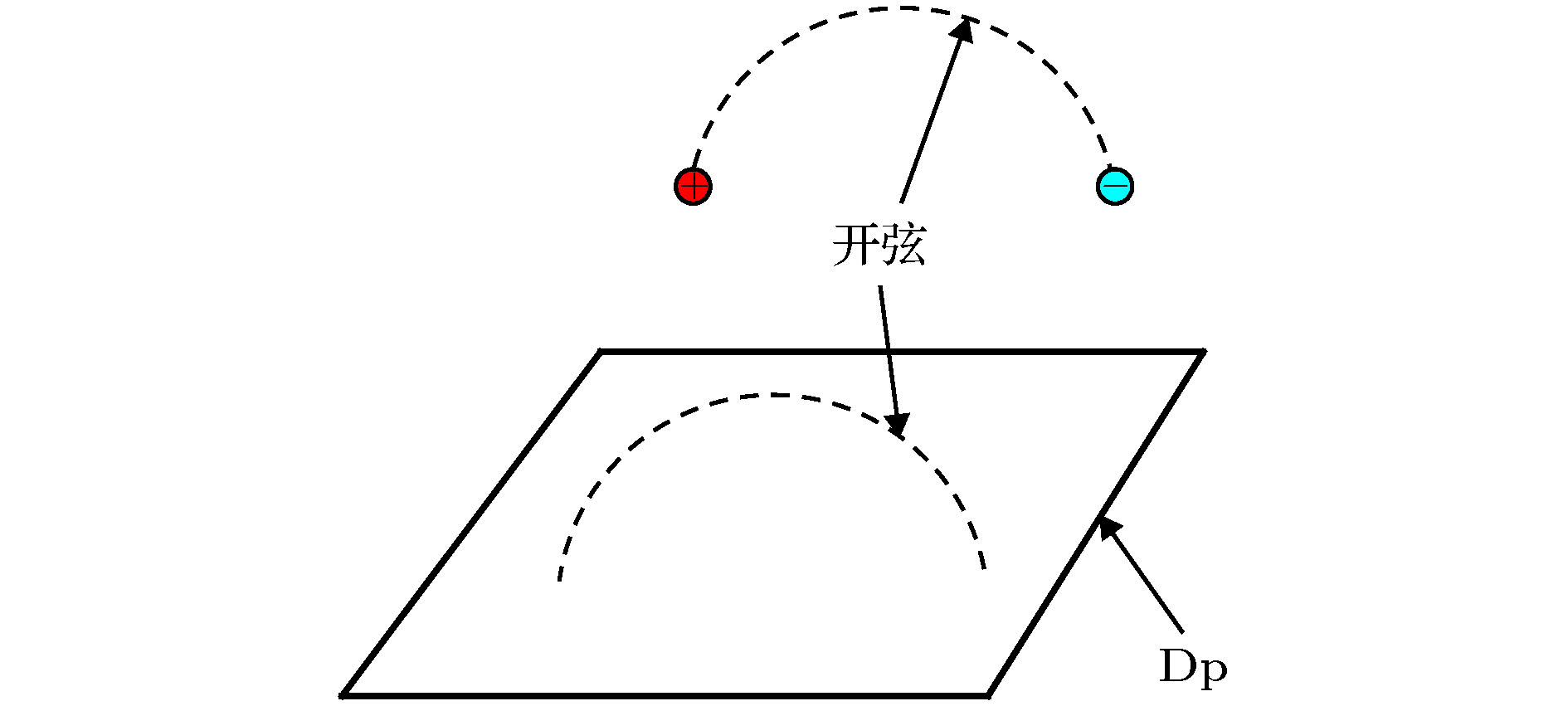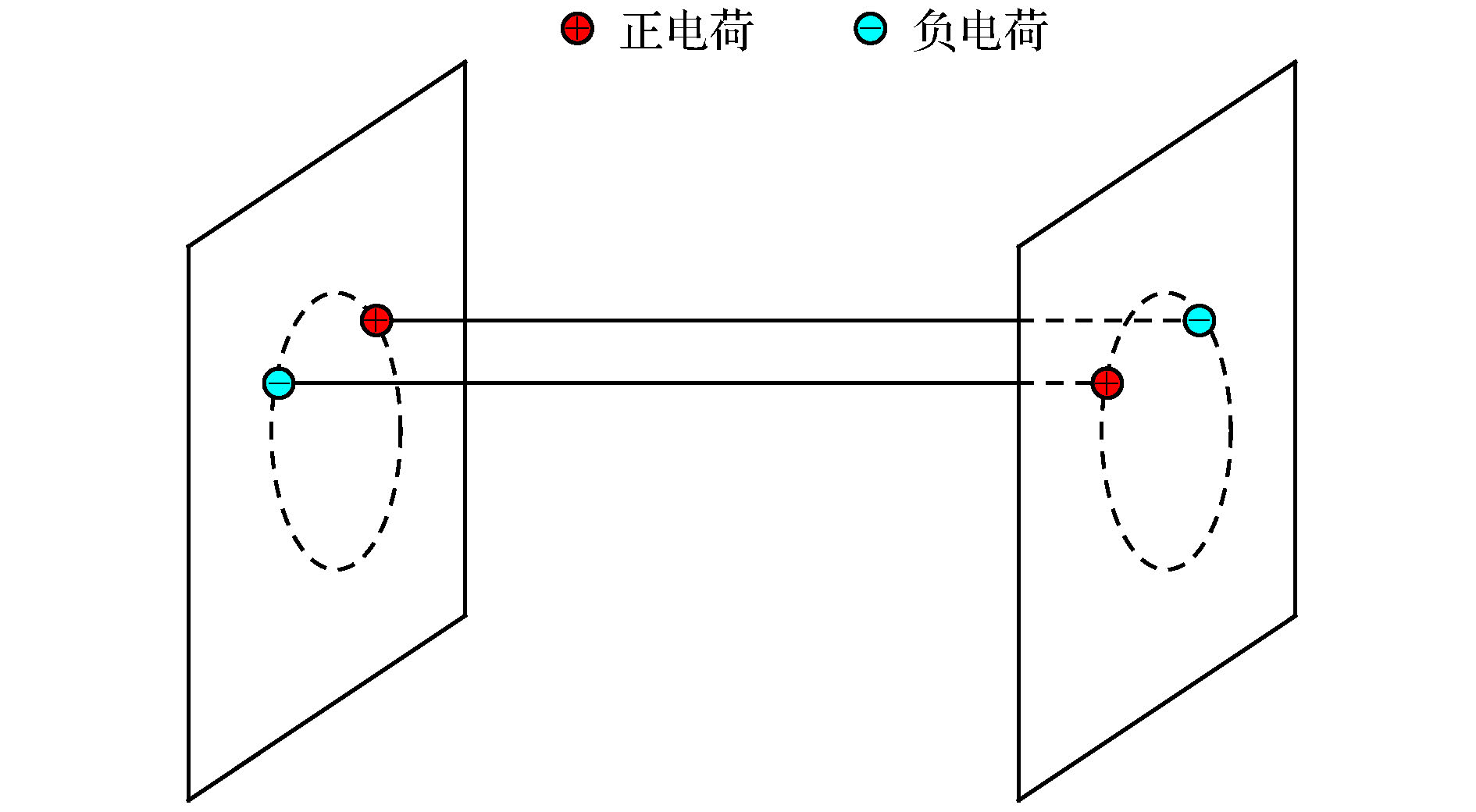-
This review article reports the recent studies, based on a series of publications by one of the present authors along with his collaborators, regarding the interaction between two D-branes, the open string pair production and its possible enhancement in Type II superstring theories. Specifically, computed is the interaction amplitude between two D-branes, placed parallel at a separation, with each carrying a general worldvolume constant flux, and discussed are the amplitude properties, say, the repulsive or attractive nature of the interaction. When at least one of the D-branes carries an electric flux, the interaction amplitude can have an imaginary part, reflecting the instability of the underlying system via the open string pair production. The decay rate and the pair production rate are both computed. In addition, the enhancement of the latter is found when the added electric and magnetic fluxes are correlated in both magnitude and direction in a certain manner. In particular, when one of the branes is D3 and the other is D1, the corresponding pair production rate becomes large enough to be tested in an earthbound laboratory. Note that the pair production rate is related to the brane separation along the direction transverse to both branes, therefore, to the extra-dimensions with respect to the brane observer. So if the underlying string theory is relevant and the D3 can be taken as our own 4-dimensional world, measuring, say, the electric current due to the pair production and comparing it against the added electric and magnetic fields to see if the measurements agree with the prediction of the computations. This can be used to verify the existence of extra-dimensions. Further, this provides also a potential new means to test the underlying string theory without the need of compactifying it to four dimensions.
-
Keywords:
- D-branes /
- strings and branes
[1] Dai J, Leigh R G, Polchinski J 1989 Mod. Phys. Lett. A 4 2073
 Google Scholar
Google Scholar
[2] Duff M J, Lu J X 1991 Phys. Lett. B 273 409
 Google Scholar
Google Scholar
[3] Duff M J, Lu J X 1994 Nucl. Phys. B 416 301
 Google Scholar
Google Scholar
[4] Duff M J, Khuri R R, Lu J X 1995 Phys. Rep. 259 213
 Google Scholar
Google Scholar
[5] Polchinski J 1995 Phys. Rev. Lett. 75 4724
 Google Scholar
Google Scholar
[6] Lu J X, Ning B, Roy S, Xu S S 2007 JHEP 0708 042
[7] Lu J X, Ning B, Wei R, Xu S S 2009 Phys. Rev. D 79 126002
 Google Scholar
Google Scholar
[8] Lu J X, Xu S S 2009 JHEP 0909 093
[9] Lu J X, Xu S S 2009 Phys. Lett. B 680 387
 Google Scholar
Google Scholar
[10] Lu J X 2017 JHEP 1712 076
[11] Lu J X 2018 Nucl. Phys. B 934 39
 Google Scholar
Google Scholar
[12] Jia Q, Lu J X 2019 Phys. Lett. B 789 568
 Google Scholar
Google Scholar
[13] Lu J X 2019 Phys. Lett. B 788 480
 Google Scholar
Google Scholar
[14] Jia Q, Lu J X, Wu Z, Zhu X 2020 Nucl.Phys. B 953 114947
 Google Scholar
Google Scholar
[15] Lu J X 2019 JHEP 1910 238
[16] Vecchia P Di, Liccardo A 2000 NATO Adv. Study Inst. Ser. C. Math. Phys. Sci. 556 1
[17] Vecchia P Di, Liccardo A 1999 arXiv: hep-th/9912275 [hep-th]
[18] Schwinger J S 1951 Phys. Rev. 82 664
 Google Scholar
Google Scholar
[19] Bachas C, Porrati M 1992 Phys. Lett. B 296 77
 Google Scholar
Google Scholar
[20] Porrati M 1993 arXiv: hep-th/9309114 [hep-th]
[21] Billo M, Vecchia P Di, Frau M, Lerda A, Pesando I, Russo R, Sciuto S 1998 Nucl. Phys. B 526 199
 Google Scholar
Google Scholar
[22] Vecchia P Di, Frau M, Lerda A, Liccardo A 2000 Nucl. Phys. B 565 397
 Google Scholar
Google Scholar
[23] Callan C G, Lovelace C, Nappi C R, Yost S A 1987 Nucl. Phys. B 288 525
 Google Scholar
Google Scholar
[24] Callan C G, Lovelace C, Nappi C R, Yost S A 1987 Nucl. Phys. B 293 83
 Google Scholar
Google Scholar
[25] Callan C G, Lovelace C, Nappi C R, Yost S A 1988 Nucl. Phys. B 308 221
 Google Scholar
Google Scholar
[26] Yost S A 1989 Nucl. Phys. B 321 629
 Google Scholar
Google Scholar
[27] Polchinski J 1998 String Theory (Vol. 1) (Cambridge: Cambridge University Press) pp214–216
[28] Whittaker E T, Watson G N 1963 A Course of Modern Analysis (4th Ed. reprinted) (Cambridge: Cambridge University Press) pp467–468
[29] Hahn S, Kim Kwanglok, Kim Kwangmin, et al. 2019 Nature 570 496
 Google Scholar
Google Scholar
[30] Berenstein D 2014 Ann. Rev. Nucl. Part. Sci. 64 197
 Google Scholar
Google Scholar
[31] Nikishov A I 1970 Sov. Phys. JETP 30 660
[32] Nikishov A I 1970 Nucl. Phys. B 21 346
 Google Scholar
Google Scholar
[33] Kruglov S I 2001 Eur. Phys. J. C 22 89
[34] Ferrara S, Porrati M 1993 Mod. Phys. Lett. A 8 2497
 Google Scholar
Google Scholar
[35] Bolognesi S, Kiefer F, Rabinovici E 2013 JHEP 1301 174
-
表 1 对于
$p \leqslant 6$ , 决定相应本征值所需要的方程Table 1. The equations needed to determine the corresponding eigenvalues for
$ p \leqslant 6$ .p 本征值满足的关系 0 $\lambda = 1$ 1 $\lambda_{0} + \lambda^{-1}_{0} = {\rm{tr} } { {w}}$ 2 $\lambda_{0} + \lambda^{-1}_{0} = {\rm{tr} } { {w}} - 1$, $\lambda = 1$ 3 $\displaystyle\sum_{\alpha =0}^{1} (\lambda_{\alpha} + \lambda^{-1}_{\alpha}) = {\rm{tr} } { {w}}, \;\;\displaystyle\sum_{\alpha =0}^{1} (\lambda^{2}_{\alpha} + \lambda^{-2}_{\alpha}) = {\rm{tr} } { {w}}^{2}$ 4 $\displaystyle\sum_{\alpha =0}^{1} (\lambda_{\alpha} + \lambda^{-1}_{\alpha}) = {\rm{tr} } { {w}} - 1, \;\;\displaystyle\sum_{\alpha =0}^{1} (\lambda^{2}_{\alpha} + \lambda^{-2}_{\alpha}) = {\rm{tr} } { {w}}^{2} - 1, \, \lambda = 1$ 5 $\displaystyle\sum_{\alpha =0}^{2} (\lambda_{\alpha} + \lambda^{-1}_{\alpha}) = {\rm{tr} } { {w}}, \;\;\displaystyle\sum_{\alpha =0}^{2} (\lambda^{2}_{\alpha} + \lambda^{-2}_{\alpha}) = {\rm{tr} } { {w}}^{2}, \;\;\displaystyle\sum_{\alpha =0}^{2} (\lambda^{3}_{\alpha} + \lambda^{-3}_{\alpha}) = {\rm{tr} } { {w}}^{3}$ 6 $\displaystyle\sum_{\alpha =0}^{2} (\lambda_{\alpha} + \lambda^{-1}_{\alpha}) = {\rm{tr} } { {w}} - 1, \;\;\displaystyle\sum_{\alpha =0}^{2} (\lambda^{2}_{\alpha} + \lambda^{-2}_{\alpha}) = {\rm{tr} } { {w}}^{2} - 1, $ $\displaystyle\sum_{\alpha =0}^{2} (\lambda^{3}_{\alpha} + \lambda^{-3}_{\alpha}) = {\rm{tr} } { {w}}^{3} - 1,$ $ \lambda = 1$ 表 2 振幅表达式((44)式)方括号中
$\theta$ 项及其简化Table 2. The
$\theta$ -terms in the square bracket in Eq. (44) and their simplification.p 振幅表达式((44)式)方括号中$\theta$项及其简化 0 $\theta^{4}_{3} (0 |it) - \theta^{4}_{4} (0 |it) - \theta^{4}_{2} (0 | it) = 2\, \theta^{4}_{1} (0 | it) = 0$ 1 或 2 $\theta^{3}_{3} (0 |it) \theta_{3} (\nu_{0} |it) - \theta^{3}_{4} (0 |it) \theta_{4} (\nu_{0} |it) - \theta^{3}_{2} (0 |it) \theta_{2} (\nu_{0} | it) = 2\, \theta^{4}_{1} \left(\left.\dfrac{\nu_{0}}{2}\right| it \right)$ 3 或 4 $\theta^{2}_{3} (0 |it) \theta_{3} (\nu_{0} |it) \theta_{3} (\nu_{1} |it)- \theta^{2}_{4} (0 |it) \theta_{4} (\nu_{0} |it) \theta_{4} (\nu_{1} |it)- \theta^{2}_{2} (0 |it) \theta_{2} (\nu_{0} | it)\theta_{2} (\nu_{1} | it)$$= 2\, \theta^{2}_{1} \left(\left.\dfrac{\nu_{0} + \nu_{1} }{2}\right|it \right) \theta^{2}_{1} \left(\left.\dfrac{\nu_{0} - \nu_{1} }{2}\right|it \right)$ 5 或 6 $\theta_{3} (0 |it) \theta_{3} (\nu_{0} |it) \theta_{3} (\nu_{1} |it) \theta_{3} (\nu_{2} |it) - \theta_{4} (0 |it) \theta_{4} (\nu_{0} |it) \theta_{4} (\nu_{1} |it) \theta_{4} (\nu_{2} |it)$$ - \theta_{2} (0 |it) \theta_{2} (\nu_{0} | it)\theta_{2} (\nu_{1} | it) \theta_{2} (\nu_{2} | it) $ $= 2\, \theta_{1} \left(\left.\dfrac{\nu_{0} + \nu_{1} + \nu_{2} }{2}\right| it \right) \theta_{1} \left(\left.\dfrac{\nu_{0} - \nu_{1} + \nu_{2} }{2}\right| it \right) \theta_{1} \left(\left.\dfrac{\nu_{0} + \nu_{1} - \nu_{2} }{2}\right| it \right)\theta_{1} \left(\left.\dfrac{\nu_{0} - \nu_{1} - \nu_{2} }{2}\right| it \right) $ -
[1] Dai J, Leigh R G, Polchinski J 1989 Mod. Phys. Lett. A 4 2073
 Google Scholar
Google Scholar
[2] Duff M J, Lu J X 1991 Phys. Lett. B 273 409
 Google Scholar
Google Scholar
[3] Duff M J, Lu J X 1994 Nucl. Phys. B 416 301
 Google Scholar
Google Scholar
[4] Duff M J, Khuri R R, Lu J X 1995 Phys. Rep. 259 213
 Google Scholar
Google Scholar
[5] Polchinski J 1995 Phys. Rev. Lett. 75 4724
 Google Scholar
Google Scholar
[6] Lu J X, Ning B, Roy S, Xu S S 2007 JHEP 0708 042
[7] Lu J X, Ning B, Wei R, Xu S S 2009 Phys. Rev. D 79 126002
 Google Scholar
Google Scholar
[8] Lu J X, Xu S S 2009 JHEP 0909 093
[9] Lu J X, Xu S S 2009 Phys. Lett. B 680 387
 Google Scholar
Google Scholar
[10] Lu J X 2017 JHEP 1712 076
[11] Lu J X 2018 Nucl. Phys. B 934 39
 Google Scholar
Google Scholar
[12] Jia Q, Lu J X 2019 Phys. Lett. B 789 568
 Google Scholar
Google Scholar
[13] Lu J X 2019 Phys. Lett. B 788 480
 Google Scholar
Google Scholar
[14] Jia Q, Lu J X, Wu Z, Zhu X 2020 Nucl.Phys. B 953 114947
 Google Scholar
Google Scholar
[15] Lu J X 2019 JHEP 1910 238
[16] Vecchia P Di, Liccardo A 2000 NATO Adv. Study Inst. Ser. C. Math. Phys. Sci. 556 1
[17] Vecchia P Di, Liccardo A 1999 arXiv: hep-th/9912275 [hep-th]
[18] Schwinger J S 1951 Phys. Rev. 82 664
 Google Scholar
Google Scholar
[19] Bachas C, Porrati M 1992 Phys. Lett. B 296 77
 Google Scholar
Google Scholar
[20] Porrati M 1993 arXiv: hep-th/9309114 [hep-th]
[21] Billo M, Vecchia P Di, Frau M, Lerda A, Pesando I, Russo R, Sciuto S 1998 Nucl. Phys. B 526 199
 Google Scholar
Google Scholar
[22] Vecchia P Di, Frau M, Lerda A, Liccardo A 2000 Nucl. Phys. B 565 397
 Google Scholar
Google Scholar
[23] Callan C G, Lovelace C, Nappi C R, Yost S A 1987 Nucl. Phys. B 288 525
 Google Scholar
Google Scholar
[24] Callan C G, Lovelace C, Nappi C R, Yost S A 1987 Nucl. Phys. B 293 83
 Google Scholar
Google Scholar
[25] Callan C G, Lovelace C, Nappi C R, Yost S A 1988 Nucl. Phys. B 308 221
 Google Scholar
Google Scholar
[26] Yost S A 1989 Nucl. Phys. B 321 629
 Google Scholar
Google Scholar
[27] Polchinski J 1998 String Theory (Vol. 1) (Cambridge: Cambridge University Press) pp214–216
[28] Whittaker E T, Watson G N 1963 A Course of Modern Analysis (4th Ed. reprinted) (Cambridge: Cambridge University Press) pp467–468
[29] Hahn S, Kim Kwanglok, Kim Kwangmin, et al. 2019 Nature 570 496
 Google Scholar
Google Scholar
[30] Berenstein D 2014 Ann. Rev. Nucl. Part. Sci. 64 197
 Google Scholar
Google Scholar
[31] Nikishov A I 1970 Sov. Phys. JETP 30 660
[32] Nikishov A I 1970 Nucl. Phys. B 21 346
 Google Scholar
Google Scholar
[33] Kruglov S I 2001 Eur. Phys. J. C 22 89
[34] Ferrara S, Porrati M 1993 Mod. Phys. Lett. A 8 2497
 Google Scholar
Google Scholar
[35] Bolognesi S, Kiefer F, Rabinovici E 2013 JHEP 1301 174
Catalog
Metrics
- Abstract views: 8535
- PDF Downloads: 274
- Cited By: 0















 DownLoad:
DownLoad:







